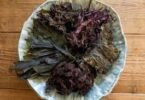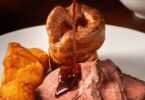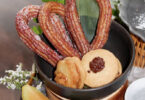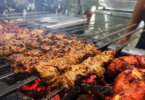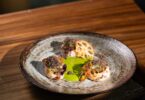Nicole Barua
Cooking one’s own meals is a joyous experience. It gives you more control over what and how much you consume, and is easier on the pocket. Also, once you get used to cooking, it’s easy to jazz things up and make your kitchen feel like an exotic destination with you traversing the globe via your taste buds. This set of recipes aims to do just that, through the humble yet versatile clam.
My adoration for molluscs is evident in my recipe repertoire, which houses numerous clam-based bounties. To me, the idea of delighting in each sweet, meaty morsel is a gateway to memories of laughing and lunching with family and friends by the beach in Goa, before running back into the ocean for a dip.
Pleasingly inexpensive and easily available, clams are also a perfect source of protein. Another pro is they cook in a jiffy, leaving you with more time to decompress after a long day of work or seize your weekend completely, so don’t let the notion of buying clams deter you if you haven’t cooked them before.
For portions, consider about 10 to 12 medium clams per serving. You may use littlenecks, steamers or Manila clams for the recipes below, which span Italian, Indian and Thai cuisines. Cooking time will differ based on size, but it’s usually between six and eight minutes or until most clams have opened.
Recipe: Spaghetti alle vongole
Serves 1
:quality(70)/cloudfront-eu-central-1.images.arcpublishing.com/thenational/66UBPTYILNHDRP4Y4K5K7RQ6ZE.JPG)
A quick recipe to feed one and easily adaptable for more people with the delicious addition of a crunchy breadcrumb topping.
Ingredients and method for the clam pasta
80g-100g dry spaghetti
1 tbsp olive oil
50g red onion, diced
2 ½ cloves of garlic, chopped
½ cup non-alcoholic white wine
10-12 fresh clams
Juice of ½ lemon
Pinch of freshly crushed pepper
Sprinkle of sea salt
Handful of chopped parsley leaves
Extra virgin olive oil, to drizzle
Boil the water for the pasta 10 minutes before you’re ready to cook. Salt the water heavily and add some oil to it.
Cook the pasta for a minute less than the time mentioned on the box, then drain and keep aside.
In another saucepan, moderately heat the olive oil, add the diced onion and stir until translucent. Add the chopped garlic and stir until fragrant.
Add the non-alcoholic wine and let it evaporate a bit. Then gently add the clams to the sauce and stir once. Lower to a medium flame, and cover with a lid to steam.
Take a peek in about four minutes; if all the clams haven’t opened, give it another minute or two. Once the majority have opened up, they are done.
Add the drained pasta to the pan, make sure to cook only for a minute more while adding salt, pepper and lime juice. Stir well to incorporate everything in the sauce.
Turn off the flame, then add the parsley and a bit more salt and extra virgin olive oil (optional).
Ingredients and method for the anchovy crumb topping (optional)
½ tbsp olive oil
½ tbsp butter
2 anchovies, chopped roughly
1 garlic clove, fine chopped
4 capers
4 tbsp fresh breadcrumbs (3 tbsp if using ready breadcrumbs)
¼ tsp dried parsley
½ tsp lemon juice
Heat the oil and butter in a pan. Add the anchovies, garlic and capers. Allow to cook slightly, then add the breadcrumbs, parsley and lemon juice. Stir continuously until crispy and golden brown.
Top the pasta with the anchovy crumbs and serve.
Note: If you’re not making the crumb topping, add some red pepper flakes to the pasta to give it an edge.
Recipe: Kakka irachi ularthiyathu (Kerala clams)
Serves 2
:quality(70)/cloudfront-eu-central-1.images.arcpublishing.com/thenational/SQPLM2HYDZGQREAHMRCHUBLCXI.JPG)
The sweetness of the clams plays perfectly with the unctuous coconut and medley of spices in this dish, which pairs well with dal, rice and poppadum.
Ingredients
600g fresh clams in the shell
2 tbsp coconut oil
2 green chilis
½ inch ginger, julienned
½ tsp mustard seeds
5-6 curry leaves
60g red onion, diced
40g coconut, desiccated
1 tbsp coriander stalks, chopped
½ tsp turmeric
¼ tsp red chilli powder
¼ tsp pepper, crushed
1 tsp garam masala
Fresh green peppercorns (optional)
½ tsp fennel seeds, toasted
½ tsp salt
2 tbsp water
Coriander leaves and lime wedges, to garnish
Method
Once the clams are depurated, drain them and set in a wide pot with a lid but without any oil or water. Turn the stove on low and cook for eight to 10 minutes or until most are open. Shake the pot once in a while to help the heat distribute more evenly.
In another pan, heat the coconut oil and add the mustard seeds. Once they sputter, add the curry leaves, chilli, ginger and fresh pepper. Then add the onion on a high flame and stir continuously, not allowing them to brown.
Once onions are translucent, add the coconut and stir quickly to toast it. Next, lower the flame and begin adding all the powdered spices plus the garam masala. Stir well and briskly to cook off the masalas.
Add the coriander stalks. If the mix is catching at the bottom, add a spoon of water and salt. By now, the clams should be cooked and open.
Once the masala base is ready, add the clams and the clam liquor on a low flame. Mix well to get the coconut base into the clams.
Cover and cook gently for three-four minutes. In the last minute, add the fennel, stir and cover.
Garnish with coriander and lime wedges.
Recipe: Hoi pad prik pao (spicy Thai clams)
Serves 4 to 6
:quality(70)/cloudfront-eu-central-1.images.arcpublishing.com/thenational/COXLJ6W6NBBV7P33RSUYIKXKP4.JPG)
This is inspired by my favourite dish at Dubai’s Sticky Rice restaurant. Sweet clams cooked in a roasted chilli paste create a fiery spectacle of a dish that is truly addictive.
Ingredients
8-12 Thai bird’s eye chilli (8 for medium heat, 12 for spicy)
4 and 6 garlic cloves, divided
5 small Thai shallots
1kg fresh clams (in shell)
1 tsp fennel seeds
1½ tsp belacan or shrimp paste
1 tbsp rice vinegar
2½ tbsp fresh tamarind paste
1 tbsp white sugar
1 tbsp soy sauce
1 tbsp oyster sauce
2 spring onions (optional)
Handful of Thai basil
3 tbsp neutral oil
Method
Ready the tamarind paste, by mixing ¼ cup tamarind with ½ cup warm water. Squeeze the tamarind to get a paste and run it through a sieve. Alternatively, use store-bought paste, but take into consideration it contains sugar.
In a pan, dry-roast the chillis after piercing them with a knife, so they don’t explode once heated. Move the chillis around in the pan, until they blister and char all over. Remove, cut the stems and set aside.
Roast four garlic cloves the same way, followed by the shallots and fennel. They are done when they become fragrant.
In a small grinder, add the roasted ingredients, the 2½ tbsp tamarind paste, rice vinegar and belacan. (If belacan is too strong for you, add it in increments, but it adds umami to the dish). Grind to a paste.
Chop the rest of the garlic and fry it in a spoon of oil in a non-stick wok. Remove and set aside.
Add the rest of the oil and begin frying the spice paste on high heat, constantly stirring. On a medium flame, add the oyster sauce and soy sauce.
Add the sugar and stir (add a splash of water if the consistency is too dry). Add the clams once the sugar has melted. Stir well, cover with a lid and cook until the clams open, releasing their liquor, which takes about eight to 10 minutes.
Once done, add some basil gently ripped by hand, and spring onions cut in quarters. Stir well.
Serve immediately with more basil, jasmine rice and a side of greens such as wilted spinach or morning glory with garlic.
Note: If the dish is too spicy, taste before serving and adjust the heat with more sugar.
Tips for cooking with clams
- Only buy clams from a reputable fishmonger or supermarket.
- Store in the refrigerator and cook within two days of purchase.
- Before cooking, check the outer shell for grit, which you can brush off with a hard bristle brush under running water.
- To depurate clams of sand, set them in a bowl of cool, clean tap water for 10 to 15 minutes. Repeat until the water is clear of sand.
- To tell if a clam is fresh, give each a hard tap against the counter and see that it remains closed tightly.
- Conversely, only eat clams that open up on the heat and discard the ones that remain closed even after cooked.
Courtesy: thenationalnews

